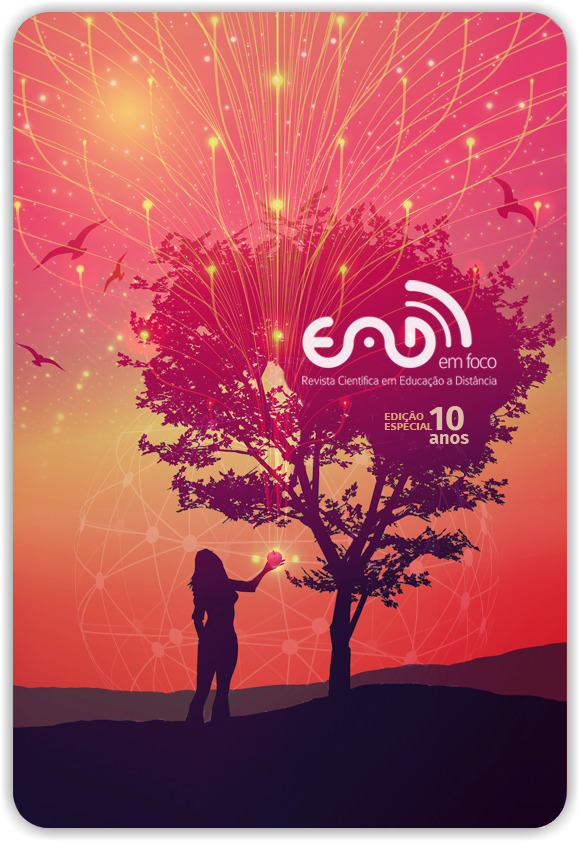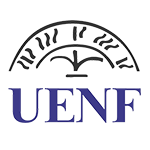Augmented Reality and Interdisciplinarity: the Use of LandscapAR Application in the Teaching of Mathematics and Geography
DOI:
https://doi.org/10.18264/eadf.v10i2.1049Abstract
This article is guided by the results of a research that sought to reflect on a didactic action. The methodology used is deployed by means of qualitative research, in the perspective of a case study, with a class in the public school of the Paraná state, where all individuals are high school students and belonging to a generation Z, which the general objective of the research was to verify if abstractions occurred and if cognitive appropriations were legitimized, in an interdisciplinary case of geography and mathematics, using the application LandscapAR. The results pointed to a more participatory learning process of the students in the interaction with this augmented reality application, and, in the same measure, they appropriated the intended concepts.
Keywords: Geography teaching. Mathematics education. Media literacy. Augmented reality. LandscapAR.
Downloads
References
ALVES, Z. M. M. B.; SILVA, M. H.G. F. Análise qualitativa de dados de entrevista: uma proposta.Paidéia,Ribeirão Preto, v. ?, n. ?, p. ??-??, 1992. Disponível em: ?. Acesso em: ?.
ANDRÉ, M. E. D. A. Texto, contexto e significado: algumas questões na análise de dados qualitativos. Cadernos de Pesquisa. 1983
CARDOSO, R. G. S; PEREIRA, S. T; CRUZ, J. H; ALMEIDA, W. R.M.Uso da realidade aumentada em auxílio í educação. Computer on the Beach, cidade?, v. ?, n. ?, p. ??-??,2014. Disponível em: https://siaiap32.univali.br/seer/index.php/acotb/article/view/5337. Acesso em: 28 maio 2019.
CASTELLS, M.; CARDOSO, G. A Sociedade em Rede do Conhecimento í Acção Política. Centro Cultural de Belém, Belém, 2005. Disponível em:https://cienciastecnologiassociedades.files.wordpress.com/2011/11/sociedade-em-rede-manuel-castells-gustavo-cardoso-org.pdf. Acesso em: 23 maio2019.
CHRISTOFOLETTI, A. Geomorfologia. 2. ed. São Paulo: Edgard Blücher, 1980.
FERNANDES, M. E.Memória Camponesa.In: REUNIíO ANUAL DE PSICOLOGIA, 21., 1991, Ribeirão Preto.Anais [...].Ribeirão Preto: SPRP, 1991. p. ??-??.
GADOTTI, M. História das idéias pedagógicas. São Paulo: Editora ítica, 2003. Disponível em:http://acervo.paulofreire.org:8080/xmlui/handle/7891/2787?. Acesso em: 10 maio 2019.
IBGE – Instituto Brasileiro de Geografia e Estatística. IBGE divulga o rendimento domiciliar per capita 2018. Agência de notícias IBGE, Estatísticas sociais, Brasil, fev. 2019. Disponível em: https://agenciadenoticias.ibge.gov.br/agencia-sala-de-imprensa/2013-agencia-de-noticias/releases/23852-ibge-divulga-o-rendimento-domiciliar-per-capita-2018. Acesso em: 05 jun. 2019.
KUCHARSKI, Marcos Vinicius Santos. Fundamentos de Inovação e Tecnologia na Educação. Especialização em Inovação e Tecnologias na Educação (INTEDUC). Universidade Tecnológica Federal (UTFPR), 2019.
KIRNER, C.; KIRNER, T. G.. Evolução e Tendências da Realidade Virtual e da Realidade Aumentada.In: SYMPOSIUM ON VIRTUAL REALITY AND AUGMENTED REALITY, 13., 2011, Uberlândia-MG. Realidade Virtual e Aumentada: Aplicações e Tendências.Uberlândia, MG: SBC, 2011. cap. 01, p. 10-25. Disponível em: http://www.de.ufpb.br/~labteve/publi/2011_svrps.pdf. Acesso em: 28 maio2019
LÉVY, P. Cibercultura. São Paulo: Editora 34, 1999.
MORAN, J. M. Uma lenta evolução. [Entrevista concedida a] Gabriel Jareta. Guia de Educação a Distância, São Paulo,n. ?, ano ?, p. 8-10,2014.Disponível em: http://www2.eca.usp.br/moran/wp-content/uploads/2013/12/evolucao.pdf. Acesso em: 10 maio 2019.
PENTEADO, M. M. Fundamentos de geomorfologia. 3. ed. Rio de Janeiro: IBGE, 1983. Disponível em: https://biblioteca.ibge.gov.br/visualizacao/livros/liv81427.pdf. Acesso em: 30 maio 2019.
PEREIRA, F. da C.; AZEVEDO, D. P. G. D. de; ALMEIDA, A. de S.; FELíCIO, C. B.; RISSE, L. S.; MOREIRA, L. B.Funções cognitivas e os impactos das tecnologias digitais na memória.Temas em saúde, João Pessoa,v. 18, n. 4, p. ??-??, 2018. Disponível em: http://temasemsaude.com/wp-content/uploads/2018/12/18412.pdf. Acesso em: 01 jul. 2019.
PINTO, F. S. CENTENO, J. A. S. A realidade aumentada em smartphones na exploração de informações estatísicas e cartográficas.Boletim de Ciências Geodésicas, Curitiba, v.18, n.2, p. ??-??, Abr./Jun. 2012. Disponível em: ?. Acesso em: ?.
PRENSKY, M. Digital Natives, Digital Immigrants. OntheHorizon, Bradford, v. 9, n. 5, p. 2-6, out. 2001. Disponível em: http://poetadasmoreninhas.pbworks.com/w/file/fetch/60222961/Prensky%20-%20Imigrantes%20e%20nativos%20digitais.pdf . Acesso em: 15 maio2019.
PRENSKY, M. Aprendizagem Baseada em Jogos Digitais. São Paulo: Senac-SP, 2012.
RESENDE, Vitor. Literacia midiática: Breve panorama sobre os estudos no Brasil.São Paulo: COMUNICON, 2016. Disponível em:http://anais-comunicon2016.espm.br/GTs/GTPOS/GT8/GT08-VITOR_RESENDE.pdf. Acesso em: 20 maio2019.
SANTAELLA, L. Comunicação ubíqua: repercussões na cultura e na educação.São Paulo: Paulus, 2013.
SILVA, M.; VILAR, E.; REIS, G.; LIMA, J. P.; TEICHRIEB, V. AR Jigsaw Puzzle: Potencialidades de Uso da Realidade Aumentada no Ensino de Geografia. In:Congresso Brasileiro de Informática na Educação, 3., 2014, cidade?.Anais[...]. cidade de publicação?: CBIE, 2014. p. ??-??. Disponível em: . Acesso em: .
SILVA, T. de O.; SILVA, L. T. G. Os impactos sociais, cognitivos e afetivos sobre a geração de adolescentes conectados í s tecnologias digitais. Revista de psicopedagogia, São Paulo, v. 34, n. 103, p. 87-97, 2017. Disponível em http://pepsic.bvsalud.org/scielo.php?script=sci_arttext&pid=S0103-84862017000100009&lng=pt&nrm=iso . Acesso em: 29 jun. 2019.
TOFFLER, A. A terceira onda. São Paulo: Record, 2001.
TOURAINE, A. Poderemos Viver Juntos? Iguais e Diferentes. Petrópolis: Editora Vozes, 1998.
VEEN, W.; VRAKKING, B. Homo zappiens: educando na era digital. Porto Alegre: Artmed, 2009.
WEEKEND, Labs UG. LandscapAR. versão 1,5.Berlin (Alemanha), jul. 2018. Disponível em:https://play.google.com/store/apps/details?id=de.berlin.reality.augmented.landscapar.
Acesso em: 30 maio2019.
Published
How to Cite
Issue
Section
License
Copyright (c) 2020 EaD em Foco

This work is licensed under a Creative Commons Attribution 4.0 International License.
All articles published in Revista EaD em Foco receive the license
Creative Commons - Atribuição 4.0 Internacional (CC BY 4.0).
All subsequent publications, complete or partial, must be made with the acknowledgment, in citations, of the Revista EaD em Foco as the original editor of the article.













